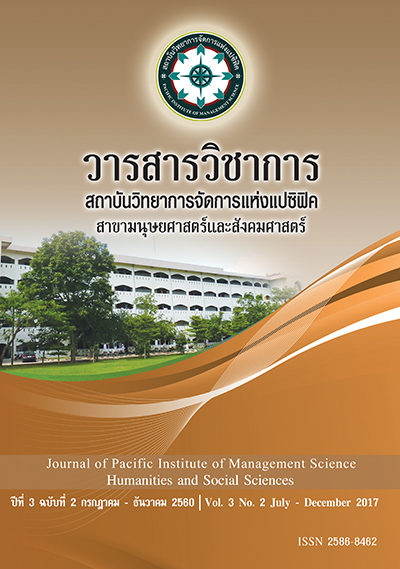Model of Management Innovation for Small-sized Schools under Office of SakonNakhon Educational Service Area 3
Keywords:
Management Innovation, Small sized SchoolsAbstract
The research entitled, “Model of Management Innovation for Small-sized Schools under Office of SakonNakhon Educational Service Area 3,” aimed 1) to study the management innovationstate of small-sizedschools under Office of SakonNakhonPrimary Educational Service Area 3, 2) to create the management innovation model of small-sized schools under Office of SakonNakhon Primary Educational Service Area 3,and 3) to evaluate the management innovation appropriateness and possibility of the small-sized schools under under Office of SakonNakhon Primary Educational Service Area 3.
The samples used in the first period of this research were 64administrators ofsmall-sized schools under Office of SakonNakhon Primary Educational Service Area 3, and 64 civil servant-teachers, who were the academic affairs heads in the small-sized schools under Office of SakonNakhon Primary Educational Service Area 3 in the academic year of 2015. While in the second period of this research, the 9 informants were invited to participate in a focus group discussion. And in last period, the 20 experts were invited to be as the informants for evaluation.
The instruments used in this research were the questionnaire, focus group discussion, and the evaluation by the experts. In the quality test, the only items of questionnaire with above .50 value of the IOC were acceptable, and in the reliability test, Cronbach’s alpha value was rated at .98. The statistics used for quantitative data analysis in this research were percentage, mean, and standard deviation. In addition, the content analysis was employed for the qualitative data which were concluded from the experts’ suggestions.
The research findings revealed that
- The level of the management innovation state of small-sized schools under Office of SakonNakhon Primary Educational Service Area 3overall was at high level. The learning organization aspect was at the highest level; the training and developmentaspect wasat the lower level, and the lowest level was the participation aspect, while organization setting was at high level. When considering each aspect, it was found that the highest level was the self-determination teachers and educational personnel, who believed in the organization creation, would be the inspiration for innovation creation. The lower level was the organization creation, which led teachers and educational personnel to collaborate the innovation, and the lowest level belonged to teachers and educational personnel, who gave significance to organization creation, while the management principle based schools was at high level.
- The management innovation model of small-sized schools under Office of SakonNakhon Primary Educational Service Area 3consisted of 5 aspects, namely, 1) the model principles, 2) the model objectives,3) model performance, 4) model evaluation, and 5) model results.
- The level of appropriateness of management innovation model of small-sized schools under Office of SakonNakhon Primary Educational Service Area 3 overall was at high level, while the result of evaluation of every aspect was at highest level.
References
การศึกษาความเป็นองค์กรนวัตกรรมของสถานศึกษาขั้นพื้นฐานสังกัดสำนักงานคณะกรรมการการศึกษาขั้นพื้นฐานใน จังหวัดราชบุรี. (2556). วิทยานิพนธ์ค.ม. ราชบุรี : มหาวิทยาลัยราชภัฏหมู่บ้านจอมบึง.
ทิศนาแขมมณีและคนอื่นๆ. (2547). วิทยาการด้านการคิด. กรุงเทพฯ : สถาบันพัฒนาคุณภาพวิชาการ.
ธีระรุญเจริญ. (2550). การบรรยายรายวิชาสัมมนาการบริหารการศึกษาเรื่อง “รูปแบบและองค์ประกอบของรูปแบบ”. ม.ป.ท. : ม.ป.พ.
บุญชม ศรีสะอาด. (2553). วิจัยเบื้องต้น. พิมพ์ครั้งที่ 8. กรุงเทพฯ : สุวีริยาสาส์น.
ประหยัดสุขสำราญ. (2555). รูปแบบการบริหารแบบมีส่วนร่วมในการจัดทำหลักสูตรสถานศึกษาขั้นพื้นฐาน. วิทยานิพนธ์ค.ม. อุบลราชธานี : มหาวิทยาลัยราชภัฏอุบลราชธานี.
พระมหาสุทิตย์อาภากโร. (2548). เครือข่ายธรรมชาติความรู้และการจัดการ. กรุงเทพฯ: โครงการเสริมสร้างการเรียนรู้ เพื่อชุมชนเป็นสุข.
พรทิพาเหลืองวัฒนกิจ. (2549). ผู้ประกอบการกับการพัฒนานวัตกรรมในพลวัตนวัตกรรม. กรงุเทพฯ : สำนักงานนวัตกรรม แห่งชาติ. 14.
สมานอัศวภูมิ. (2550). “การใช้วิจัยพัฒนารูปแบบในวิทยานิพนธ์ระดับปริญญาเอก,” วารสารมหาวิทยาลัยราชภัฏ อุบลราชธานี. 2 (กรกฎาคม – ธันวาคม 2550): 83-84.
สำนักพัฒนานวัตกรรมการจดการศึกษา. (2549). แนวทางการดำเนินงานโรงเรียนวิถีพุทธ. กรุงเทพฯ : โรงพิมพ์อุษา การพิมพ์.
อรอนงค์ โรจน์วัฒนบูลย์. (2554). การพัฒนาตัวแบบผู้นาเชิงนวัตกรรม. วิทยานิพนธ์ปริญญารัฐประศาสนศาสตรดุษฎี บัณฑิต, คณะรัฐประศาสนศาสตร์ สถาบันบัณฑิตพัฒนบริหารศาสตร์
Downloads
Published
Issue
Section
License
บทความที่ได้รับการตีพิมพ์เป็นลิขสิทธิ์ของ สถาบันวิทยาการจัดการแห่งแปซิฟิค
ข้อความที่ปรากฏในบทความแต่ละเรื่องในวารสารวิชาการเล่มนี้เป็นความคิดเห็นส่วนตัวของผู้เขียนแต่ละท่านไม่เกี่ยวข้องกับสถาบันวิทยาการจัดการแห่งแปซิฟิค และคณาจารย์ท่านอื่นๆในสถาบันฯ แต่อย่างใด ความรับผิดชอบองค์ประกอบทั้งหมดของบทความแต่ละเรื่องเป็นของผู้เขียนแต่ละท่าน หากมีความผิดพลาดใดๆ ผู้เขียนแต่ละท่านจะรับผิดชอบบทความของตนเองแต่ผู้เดียว







